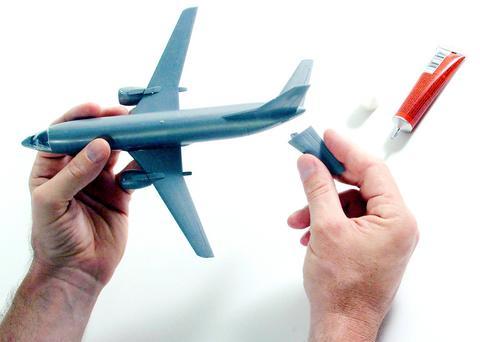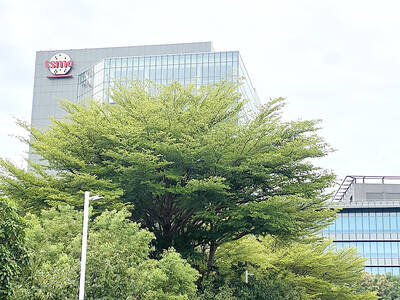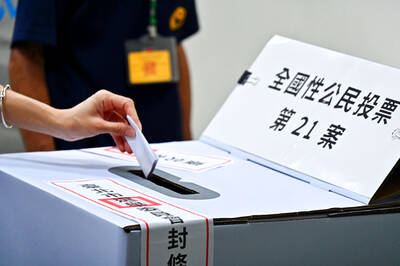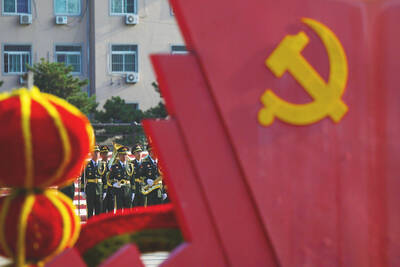Bob Dylan once warned that "as the present now will later be past, the order is rapidly fading." He meant the political establishment four decades ago, of course, but his words also apply to the airline industry today.
In a year when beleaguered carriers hoped they would bounce back into prosperity, as they have so many times before, they are instead facing a market that may have changed more fundamentally than at any time since the industry was deregulated in 1978. As a result, even the biggest companies may have to remake themselves radically, quickly and permanently, or face extinction.
The predominant business model since deregulation -- based on wide availability of service, supported by customers willing to pay a premium for convenience -- is being buried by low-fare airlines that pick and choose their destinations and continually pare costs and ticket prices.

PHOTO: NY TIMES
"This industry is transforming itself in front of our very eyes," said Patricia Friend, president of the Association of Flight Attendants, which represents 100,000 workers at several airlines.
The changes being forced on the industry today are as far-reaching as those unleashed when former US president Jimmy Carter pushed through deregulation a generation ago, she said: "This is Round 2."
Some executives say that if airlines simply trim their costs enough, they can withstand the onslaught as they did in previous slumps. But others say that the industry cannot just shrink this time, and that it must reshape itself, abandoning assumptions about consumers and labor contracts alike.
BROKEN HUBS
For example, the hub-and-spoke system, which funnels passengers from smaller cities to major ones, was embraced by most big airlines after deregulation. It may be on the endangered-species list, though, at least as the primary means of moving people around the country. And airlines are likely to evolve from one-size-fits-all megacompanies into niche operators aimed at specific demographics -- international business travelers, for example, or Florida vacation bargain hunters.
All the business models now being tested, however, share one goal: lower costs. The days when pilots were paid like CEOs are gone for good, and all employees -- including the people who clean the planes and restock the beverage carts -- will be pressured to work harder and perhaps work for less.
"The economic situation of the industry is a reality," Friend said. "We can't change that. We have no choice but to try to adapt ourselves to a new business model while preserving as much as we can."
Frank Lorenzo, the creator of the Texas Air Group, said change was long overdue. Lorenzo famously incurred the wrath of the unions in the late 1980s and early 1990s for the drastic cuts he imposed at Continental Airlines, giving it the lowest costs among major airlines as it emerged from bankruptcy protection. But he argued that the economic boom of the 1990s eased pressure on the rest of the industry to follow suit, at least until the market soured in 2001.
"The problems didn't go away," Lorenzo said in an interview. "They only got delayed. Now it's all coming home to roost."
Whatever happens, the industry will look much different from what it did after two previous waves of restructuring, resulting from economic slumps in the 1980s and 1990s. Both times, the industry essentially bounced back to its previous form, although with some casualties, including People Express, Pan American World Airways and Eastern Airlines, which shut down while Lorenzo was running it.
LOW-FARE BLUES
Back then, airlines that were in decent financial shape could "simply ride it out" and go back to charging top dollar for fares once customers returned, said Michael Levine, a former airline executive who is now an adjunct professor of law at Yale.
Lorenzo agreed, saying that a single airline hub, like O'Hare International Airport in Chicago, could generate US$50 million in revenue a month for an airline during the industry's peak years.
Paradoxically, the latest restructuring is occurring amid strong economic growth. But the gains that in the past went to the major airlines are being taken away by low-fare airlines like Southwest and JetBlue, which for the first time are gaining market share as a group, even as the big airlines fight them.
Levine compared the traditional hub-and-spoke airline industry to an iceberg drifting toward the Equator.
"Some of the carriers are higher up the iceberg, and some of them are lower down," he said. When the ice begins to melt as the environment changes, "you can hope the ones down below drown before you do," but eventually everyone will drown, he said.
The Air Transportation Stabilization Board certainly turned up the heat last month, when, for the third time in 18 months, it refused to guarantee loans for the industry's second-biggest player, United Airlines, despite the company's powerful political support. That was just as well to critics of the board, which was created in 2001 to help airlines get back on their feet after the Sept. 11 terrorist attacks. Some critics, including Herbert Kelleher, the chairman of Southwest Airlines, said the loan guarantees amounted to little more than life support for uncompetitive companies.
United will now have to arrange additional financing itself. That will mean persuading potential investors and lenders that it can survive and prosper. Other airlines with above-average costs, including Delta and US Airways, face the same challenge. None have said how they plan to become profitable again, although Delta executives are scheduled to present a restructuring plan to the company's board next month. The chief executive, Gerald Grinstein, has promised that the plan will start to revitalize the airline.
But the pressure will not end even if United, Delta and US Airways figure a way out of their problems. Henry Joyner, vice president for corporate strategy at American Airlines, a unit of the AMR Corp, foresees years of turbulence, which experts say could lead to fewer jobs, fewer hubs and ultimately, airlines that bear little resemblance to those of today.
"We are going to get to a watershed, with some greater levels of change," said Joyner, whose company has been immersed in its own 18-month restructuring drive, which has included US$1.8 billion in concessions from its labor unions.
A QUESTION OF STRATEGY
So far, the major airlines' strategy of cutting ticket prices on routes where they compete head-to-head with low-fare rivals has failed because the big carriers have not cut costs as much as fares, pushing them deeper into the red while still losing market share. Even so, the large airlines, the so-called legacy carriers, have done little to change their basic strategy -- the hub-and-spoke system -- even though the low-fare competitors have placed more emphasis on direct flights.
Executives at the large airlines, including Joyner at American, contend that a network system can still work as long as they can reduce costs and streamline operations. Others, however, are less sanguine.
"One, that doesn't get you enough in revenue," Levine said. "And, two, a lot of the management at the airlines doesn't know how to do anything but ask for cuts."
Industry innovators like David Neeleman, a veteran of Southwest and the founder and chief executive of JetBlue, contend that airlines must give up on unprofitable routes and concentrate on areas where they can dominate. Lorenzo argued that it no longer made sense to continue offering service just for the sake of being big. "Companies have got to adjust to the marketplace," he said.
If they do, the industry could fragment into brands aimed at different tiers of passengers.
At the top would be premium-fare service, with international routes like those to the Asian cities served by United and Northwest, and a few choice domestic cities where there is little competition, like Detroit, which is dominated by Northwest, or Cincinnati, where Delta accounts for nine of 10 flights. Major airlines would most likely stay on top in that class of service, because the cost of entering those markets would tend to discourage low-fare carriers.
At the bottom would be highly competitive routes that offer cheap fares and minimal profits, like short flights from Dulles International Airport near Washington or Midway International Airport in Chicago. Here, low-fare carriers would be most competitive because of their low overhead costs.
In the vast, plump middle tier, low-fare carriers and traditional airlines would vie aggressively for customers, using enticements like in-flight entertainment systems and frequent-flier programs to gain advantage.
Under such a model, airlines might be able to compete in two types of service successfully, as a carmaker might produce economy cars and family sedans. But airlines would be loath to tackle all three markets because of the expense of playing at the top, the flood of competition in the middle and the razor-thin profits at the bottom.
Grinstein at Delta is one leader of a legacy carrier who has said publicly that airlines are facing a fundamental change. In an e-mail message to employees last month, he made clear that the old order at Delta was history.
"We need to reinvent ourselves," Grinstein said. "Any notion that we can simply grow ourselves out of this predicament is mistaken.
"Many of our costs are higher than those of our competitors, and our customers will not pay us to cover the difference," he added. "We must recognize this change and act quickly to address it."
LABOR PAINS
If the situation is drastic for airline executives, it is even more painful for labor leaders, whose influence is waning. The industry has never had so many major contract talks in so many places at the same time. Nor have unions that have already granted concessions ever been in the position of facing further requests for cuts - in the case of US Airways, not just once but twice.
This erosion of power is particularly frustrating for labor leaders like Friend, whose union has spent the last 40 years transforming the work of flight attendants from essentially a way station for young women before marriage into a full-time career for employees of both sexes. Especially difficult, she said, is knowing that a deal cut at one company may not hold up if a competitor can get better terms.
Especially worrisome for both labor and management is the suspicion that no airline is too big to fail, not as long as aggressive and financially healthy rivals are around. Alain Kornhauser, professor of operations research and financial engineering at Princeton, said that "if US Airways were to disappear," other airlines would quickly replace its flights, hire its crews and lease some of its planes.
Thomas Chochan, professor of management at the Massachusetts Institute of Technology, said: "It's a terrible situation for the employees, for the customers, for the shareholders, for everyone at the moment. But unfortunately that's the world they're in."
As Dylan put it, "he that gets hurt will be he who has stalled."

Taiwan Semiconductor Manufacturing Co (TSMC, 台積電) is expected to start construction of its 1.4-nanometer chip manufacturing facilities at the Central Taiwan Science Park (CTSP, 中部科學園區) as early as October, the Chinese-language Liberty Times (the Taipei Times’ sister newspaper) reported yesterday, citing the park administration. TSMC acquired land for the second phase of the park’s expansion in Taichung in June. Large cement, construction and facility engineering companies in central Taiwan have reportedly been receiving bids for TSMC-related projects, the report said. Supply-chain firms estimated that the business opportunities for engineering, equipment and materials supply, and back-end packaging and testing could reach as high as

CHAMPIONS: President Lai congratulated the players’ outstanding performance, cheering them for marking a new milestone in the nation’s baseball history Taiwan on Sunday won their first Little League Baseball World Series (LLBWS) title in 29 years, as Taipei’s Dong Yuan Elementary School defeated a team from Las Vegas 7-0 in the championship game in South Williamsport, Pennsylvania. It was Taiwan’s first championship in the annual tournament since 1996, ending a nearly three-decade drought. “It has been a very long time ... and we finally made it,” Taiwan manager Lai Min-nan (賴敏男) said after the game. Lai said he last managed a Dong Yuan team in at the South Williamsport in 2015, when they were eliminated after four games. “There is

POWER PLANT POLL: The TPP said the number of ‘yes’ votes showed that the energy policy should be corrected, and the KMT said the result was a win for the people’s voice The government does not rule out advanced nuclear energy generation if it meets the government’s three prerequisites, President William Lai (賴清德) said last night after the number of votes in favor of restarting a nuclear power plant outnumbered the “no” votes in a referendum yesterday. The referendum failed to pass, despite getting more “yes” votes, as the Referendum Act (公民投票法) states that the vote would only pass if the votes in favor account for more than one-fourth of the total number of eligible voters and outnumber the opposing votes. Yesterday’s referendum question was: “Do you agree that the Ma-anshan Nuclear Power Plant

Democratic nations should refrain from attending China’s upcoming large-scale military parade, which Beijing could use to sow discord among democracies, Mainland Affairs Council Deputy Minister Shen You-chung (沈有忠) said. China is scheduled to stage the parade on Wednesday next week to mark the 80th anniversary of Japan’s surrender in World War II. The event is expected to mobilize tens of thousands of participants and prominently showcase China’s military hardware. Speaking at a symposium in Taichung on Thursday, Shen said that Chinese Minister of Foreign Affairs Wang Yi (王毅) recently met with Indian Prime Minister Narendra Modi during a visit to New Delhi.